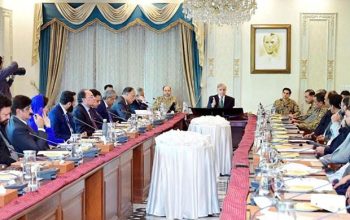The federal government has made the decision to set the new budget at an exchange rate of Rs290 to a dollar, aiming to control market expectations of a significant currency devaluation in the coming year. However, this move raises concerns about the feasibility of the budget, given the highly uncertain economic environment.
Sources told The Express Tribune that the Ministry of Finance has instructed government departments to prepare budget estimates for the fiscal year 2023-24 using the Rs290 to a dollar exchange rate. This rate is crucial for determining the defence budget, foreign debt servicing, the cost of running Pakistan’s missions abroad, and the Public Sector Development Programme (PSDP).
Any fluctuations in the dollar value or underestimation at the time of budgeting can render the entire budget unrealistic, leading to cost overruns and the need for supplementary grants.
Sources say that initially, the Ministry of Finance considered using the Rs300 to a dollar rate but later decided to fix it at Rs290 in an attempt to manage market expectations.
For the outgoing fiscal year, the government had set the rupee-dollar parity at Rs186 to a dollar for budget purposes. However, sources say, the average rupee-dollar parity for the fiscal year 2022-23 ended up being Rs249, which was 34% higher than the Finance Ministry’s initial estimate in June last year.
On Tuesday, the interbank rate for the rupee stood at Rs285.31, which was Rs27 to Rs30 per dollar lower than the open market price.
The International Monetary Fund (IMF) has requested Pakistan to share its foreign exchange policy due to the significant gap between the interbank and open market rates.
In an interview with Geo News on Sunday, Finance Minister Ishaq Dar stated that the Rs285 to a dollar rate did not reflect the true value of the rupee. According to him, the rupee was undervalued by at least 15%. Dar mentioned that his assessment of the rupee’s real value was between Rs240 to Rs249, a figure supported by an international report that put it at Rs244 to a dollar.
Pakistan is currently facing a severe shortage of foreign currency as efforts to revive the IMF program have been fruitless due to differences over external financing, exchange rate policy, and the demand for a fiscally responsible budget.
Dar has also expressed frustration with an independent central bank, particularly the ban on government borrowing from the State Bank of Pakistan (SBP), which has left the federal government dependent on commercial banks.
Due to the inaccurate rupee-dollar parity of Rs186 for the outgoing fiscal year, sources say various ministries have had to seek supplementary grants to cover their expenses. The Ministry of Information, Ministry of Commerce, and Ministry of Foreign Affairs have already received additional funds to bridge the shortfall caused by the inaccurate exchange rate.
Additionally, the Ministry of Economic Affairs has requested supplementary grants to make external debt repayments in the current fiscal year, as the allocated budget of Rs510 billion based on the Rs186 value proved insufficient. The actual cost of interest payments on external debt may exceed Rs700 billion for the outgoing fiscal year.
Based on the indicative rupee-dollar parity, sources believe interest payments on external debt are projected to reach approximately Rs1 trillion for the next fiscal year. Overall, the government aims to allocate around Rs7.5 trillion for debt servicing in the next fiscal year, which may need to be increased if the budget aligns with IMF requirements.
Finance Minister Ishaq Dar plans to unveil the new budget on June 9th, and if it meets the agreed fiscal framework, a staff-level agreement with the IMF can be reached.
The Ministry of Defence has requested a budget of Rs1.92 trillion, while the finance ministry has indicated Rs1.7 trillion thus far. The Defence Ministry is also seeking the release of foreign exchange for immediate defence imports.
Prime Minister Shehbaz Sharif received budget proposals from the country’s industrialists on Tuesday.
Published in The Express Tribune, May 31st, 2023.
Like Business on Facebook, follow @TribuneBiz on Twitter to stay informed and join in the conversation.
Read the full story at the express tribune website.


